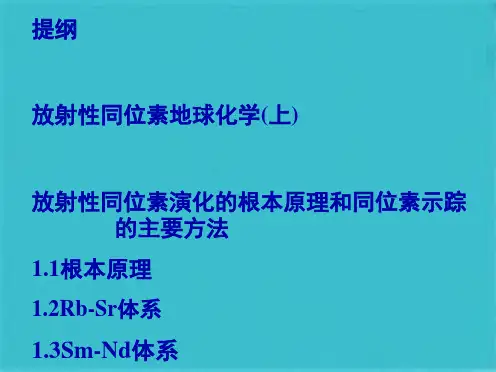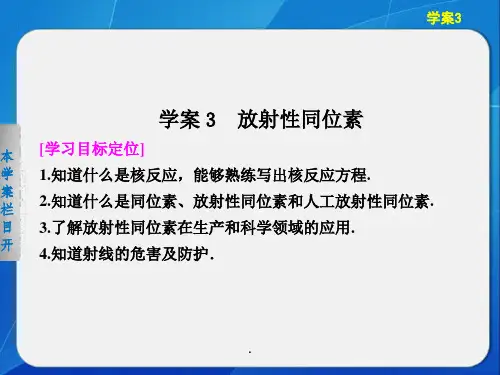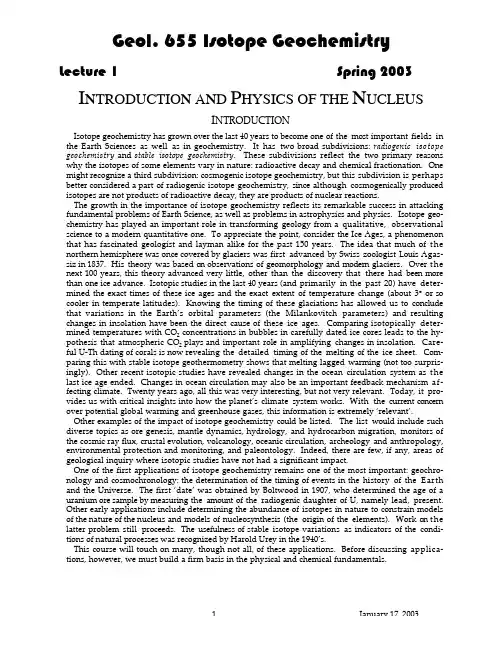放射性同位素地球化学1ppt课件
- 格式:ppt
- 大小:4.97 MB
- 文档页数:90









I NTRODUCTION AND P HYSICS OF THE N UCLEUSI NTRODUCTIONIsotope geochemistry has grown over the last 40 years to become one of the most important fields in the Earth Sciences as well as in geochemistry. It has two broad subdivisions: radiogenic isotope geochemistry and stable isotope geochemistry. These subdivisions reflect the two primary reasons why the isotopes of some elements vary in nature: radioactive decay and chemical fractionation. One might recognize a third subdivision: cosmogenic isotope geochemistry, but this subdivision is perhaps better considered a part of radiogenic isotope geochemistry, since although cosmogenically produced isotopes are not products of radioactive decay, they are products of nuclear reactions.The growth in the importance of isotope geochemistry reflects its remarkable success in attacking fundamental problems of Earth Science, as well as problems in astrophysics and physics. Isotope geo-chemistry has played an important role in transforming geology from a qualitative, observational science to a modern quantitative one. To appreciate the point, consider the Ice Ages, a phenomenon that has fascinated geologist and layman alike for the past 150 years. The idea that much of the northern hemisphere was once covered by glaciers was first advanced by Swiss zoologist Louis Agas-siz in 1837. His theory was based on observations of geomorphology and modern glaciers. Over the next 100 years, this theory advanced very little, other than the discovery that there had been more than one ice advance. Isotopic studies in the last 40 years (and primarily in the past 20) have deter-mined the exact times of these ice ages and the exact extent of temperature change (about 3° or so cooler in temperate latitudes). Knowing the timing of these glaciations has allowed us to conclude that variations in the Earth’s orbital parameters (the Milankovitch parameters) and resulting changes in insolation have been the direct cause of these ice ages. Comparing isotopically deter-mined temperatures with CO2 concentrations in bubbles in carefully dated ice cores leads to the hy-pothesis that atmospheric CO2 plays and important role in amplifying changes in insolation. Care-ful U-Th dating of corals is now revealing the detailed timing of the melting of the ice sheet. Com-paring this with stable isotope geothermometry shows that melting lagged warming (not too surpris-ingly). Other recent isotopic studies have revealed changes in the ocean circulation system as the last ice age ended. Changes in ocean circulation may also be an important feedback mechanism af-fecting climate. Twenty years ago, all this was very interesting, but not very relevant. Today, it pro-vides us with critical insights into how the planet’s climate system works. With the current concern over potential global warming and greenhouse gases, this information is extremely ‘relevant’.Other examples of the impact of isotope geochemistry could be listed. The list would include such diverse topics as ore genesis, mantle dynamics, hydrology, and hydrocarbon migration, monitors of the cosmic ray flux, crustal evolution, volcanology, oceanic circulation, archeology and anthropology, environmental protection and monitoring, and paleontology. Indeed, there are few, if any, areas of geological inquiry where isotopic studies have not had a significant impact.One of the first applications of isotope geochemistry remains one of the most important: geochro-nology and cosmochronology: the determination of the timing of events in the history of the Earth and the Universe. The first ‘date’ was obtained by Boltwood in 1907, who determined the age of a uranium ore sample by measuring the amount of the radiogenic daughter of U, namely lead, present. Other early applications include determining the abundance of isotopes in nature to constrain models of the nature of the nucleus and models of nucleosynthesis (the origin of the elements). Work on the latter problem still proceeds. The usefulness of stable isotope variations as indicators of the condi-tions of natural processes was recognized by Harold Urey in the 1940’s.This course will touch on many, though not all, of these applications. Before discussing applica-tions, however, we must build a firm basis in the physical and chemical fundamentals.P HYSICS OF THE N UCLEUSEarly Development of Atomic and the Nuclear TheoryThat all matter consists of atoms was first proposed by John Dalton, an English school teacher, in 1806. Prout showed in 1815 that atomic weights were integral multiples of the mass of hydrogen.This observation was strong support for the atomic theory, though it was subsequently shown not to hold for all elements. J. J. Thomson developed the first mass spectrograph in 1906 and provided the answer as to why the Law of Constant Proportions did not always hold: those elements not having in-teger weights had several isotopes, each of which had mass that was an integral multiple of the mass of H. In the mean time, Rutherford had made another important observation: that atoms con-sisted mostly of empty space. This led to Bohr’s model of the atom, proposed in 1910, which stated that the atom consisted of a nucleus, which contained most of the mass, and electrons in orbit about it.It was nevertheless unclear why some atoms had different mass than other atoms of the same element. The answer was provided by W. Bothe and H. Becker of Germany and James Chadwick of England: the neutron. Bothe and Becker discovered the particle, but mistook it for radiation.Chadwick won the Nobel Prize for determining the mass of the neutron in 1932. Various other experiments showed the neutron could be emitted and absorbed by nuclei, so it became clear t h a tdiffering numbers of neutrons caused some atoms to be heavier than other atoms of the same element.This bit of history leads to our first basic observation about the nucleus:it consists of protons and neutrons.Some Definitions and UnitsBefore we consider the nucleus in more detail, let’s set out some defi-nitions:N : the number of neutrons, Z : the number of protons (this is the same as atomic number, since the number of protons dictates the chemical properties of the atom), A : Mass number (N+Z), M : Atomic Mass, I :Neutron excess number (I=N-Z). Iso-topes have the same number of pro-tons, but different numbers of neutrons; isobars have the same mass number (N+Z); isotones have the same number of neutrons but different number of protons.The basic unit of nuclear mass is the dalton (formerly known as the amu, or atomic mass unit), which is based on the mass 12C ≡12, that is,the mass of 12C is 12 daltons. The masses of atomic particles are:proton: 1.007593 daltons (oramu, atomic mass units) =1.6726231 x 10-27 kg neutron 1.008982 daltonsFigure 1.1 Neutron number vs. proton number for stable nu-clides.electron 0.000548756 daltons = 9.10093897 x 10-31 kgNucleons, Nuclei, and Nuclear ForcesFigure 1.1 is a plot of N vs. Z showing which nuclides are stable. A key observation in understand-ing the nucleus is that not all nuclides (combinations of N and Z) are stable. In other words, we cannot simply throw protons and neutrons (collectively termed nucleons) together and expect them to necessarily to form a nucleus. For some combinations of N and Z, a nucleus forms, but is unstable, with half-lives from >1015yrs to <10–12sec.An interesting observation from Figure 1.1 is that N ≈Z for stable nuclei. Thus a significant portion of the nucleus consists of protons, which obviously tend to repel each other by electrostatic force. Notice also that for small A, N=Z, for large A, N>Z. This is another important observation t h a t will lead to the first model of the nucleus.From the observation that nuclei exist at all, it is apparent that another force must exist that is stronger than coulomb repulsion at short distances. It must be negligible at larger distances, otherwise all matter would collapse into a single nucleus. This force, called the nuclear force, is a manifestation of one of the fundamental forces of nature (or a manifestation of the single force in nature if you prefer unifying theories), called the strong force. If this force is assigned a strength of 1, then the strengths of other forces are: electromagnetic 10-2; weak force 10-5; gravity 10-39 (we’ll discuss the weak nuclear force later). Just as electromagnetic forces are mediated by a particle, the photon, the nuclear force is mediated by the pion. The photon carries one quantum of electromagnetic force field; the pion carries one quantum of nuclear force field. A comparison of the relative strengths of the nuclear and electromagnetic forces as a function of distance is shown in Figure 1.2.Atomic Masses and Binding EnergiesThe carbon 12 atom consists of 6 neutrons, 6 protons and 6 electrons. But using the masses listed above, we find that the masses of these 18 particles do not add to 12 daltons, the mass of 12C. There is no mistake, they do not add up. What has happened to the extra mass? The mass has been converted to the energy binding the nucleons.It is a general physical principle that thelowest energy configuration is the most stable. We would expect that if 4He is stable relative to two free neutrons and two free protons, 4He must be a lower energy state compared to the free particles. If this is the case, then we can predict from Einstein's mass-energy equiva-lence:E = mc2 1.1that the 4He nucleus has less mass that 2 free neutrons and protons. It does in fact have less mass. From the principle that the lowest energy configurations are the most stable and the mass-energy equivalence, we should be able to predict the relative stability of various nuclei from their masses alone.We define the mass decrement of an atom as:d = W – M 1.210–410–510–610–710–810–910–10Distance, 10-12 cmV,ergsFigure 1.2. The nuclear and electromagnetic potential of a proton as a function of distance from the proton.where W is the sum of the mass of the constituent particles and M is the actual mass of the atom. For example, W for 4He is W = 2m p +2m n + 2m e = 4.034248 daltons. The mass of 4He is 4.003873 daltons, so d = 0.030375 daltons. Converting this to energy using Equ. 1.1 yields 28.28 MeV. This energy is known as the binding energy . Dividing by A,the mass number, or number of nu-cleons, gives the binding energy per nucleon , E b :E b =W –M Ac21.10This is a measure of nuclear stabil-ity: those nuclei with the largestbinding energy per nucleon are the most stable. Figure 1.3 shows E b as a function of mass. Note that the nucleons of intermediate mass tend to be the most stable. This distribution of binding energy is important to the life history of stars, the abundances of the elements, and radioactive decay, as we shall see.Some indication of the relative strength of the nuclear binding force can be obtained by comparing the mass decrement associated with it to that associated with binding an electron to a proton in a hydrogen atom. The mass decrement we calculated above for He is of theorder of 1%, 1 part in 102. The massdecrement associated with bindingan electron to a nucleus of the orderof 1 part in 108. So bonds between nucleons are about 106 times stronger than bonds between electrons and nuclei.The Liquid Drop ModelWhy are some combinations of N and Z more stable than others? The answer has to do with the forces between nucleons and how nucleons are organized within the nucleus. The structure and organi-zation of the nucleus are questions still being actively researched in physics, and full treatment is cer-tainly beyond the scope of this class, but we can gain some valuable insight to nuclear stability by considering two of the simplest models of nuclear structure. The simplest model of the nucleus is the liquid-drop model , proposed by Niels Bohr in 1936. This model assumes all nucleons in a nucleus have equivalent states. As its name suggests, the model treats the binding between nucleons as similar to the binding between molecules in a liquid drop. According to the liquid-drop model, the total bindingFigure 1.3 Binding energy per nucleon vs. mass number.Figure 1.4 Variation of surface, coulomb, and volume energy per nucleon vs. mass number.of nucleons is influenced by 4 effects: a volume energy, a surface energy, an excess neutron energy, and a coulomb energy. The variation of three of these forces with mass number and their total effect is shown in Figure 1.4.In the liquid drop model, the binding energy is given by the equation:B(A,I)= a 1A – a 2A 2/3 – a 3I 2/4A – a 4Z 2/4A 3 + d1.11where:a 1: heat of condensation (volume energy µA) = 14 MeV a 2: surface tension energy = 13 MeV a 3: excess neutron energy = 18.1 MeV a 4: coulomb energy = 0.58 MeVd : even-odd fudge factor. Binding energy greatest for even-even and smallest for odd-odd.Some of the nuclear stability rules above can be deduced from equation 1.11. Solutions for equation 1.11 at constant A, that is for isobars, result in a hyperbolic function of I, as illustrated in Figure 1.5.For odd A, one nuclei will lie at or near the bottom of this function (energy well). For even A,twoFigure 1.5 Graphical illustration of total binding energies of the isobars of mass number A= 81 (left) and A=80 (right). Energy values lie on parabolas, a single parabola for odd A and two parabolas for even A. Binding energies of the 'last'proton and 'last' neutrons are approximated by the straight lines in the lower part of the figure. After Suess (1987).curves result, one for odd-odd, and one for even-even. The even-even curve will be the one with the lower (more stable) one.Odd-Even Effects and Magic NumbersSomething that we have alluded to and which the liquid drop model does not explain well is the even-odd effect. This effect is illustrated in Table 1.1. Clearly, even combinations of nuclides are much more likely to be stable than odd ones. This is the first indication that the liquid drop model does not provide a complete description of nuclear stability. Another observation not explained by the liquid drop model is the so-called Magic Numbers. The Magic Numbers are 2, 8, 20, 28, 50, 82, and 126. Some observations about magic numbers:1. Isotopes and isotones with magic numbers are unusually common (i.e., there are a lot of differentnuclides in cases where N or Z equals a magic number).2. Magic number nuclides are unusually abundant in nature (high concentration of the nuclides).3. Delayed neutron emission in fission occurs in nuclei containing N*+1 (where N* denotes a magicnumber) neutrons.4. Heaviest stable nuclides occur at N=126 (and Z=83).5. Binding energy of last neutron or proton drops for N*+1.6. Neutron-capture cross sections for magic numbers are anomalously low.7. Nuclear properties (spin, magnetic moment, electrical quadrupole moment, metastable isomericstates) change when a magic number is reached.Table 1.1. Numbers of stable nuclei for odd and even Z and NZ N A number of stable nuclei number of very long-lived nuclei(Z + N)odd odd even45odd even odd503even odd odd553even even even16511The Shell Model of the NucleusThe state of the nucleus may be investigated in a number of ways. The electromagnetic spectra emitted by electrons is the principal means of investigating the electronic structure of the atom. B y analogy, we would expect that the electromagnetic spectra of the nucleus should yield clues to its structure, and indeed it does. However, the g spectra of nuclei are so complex that not much progress has been made interpreting it. Observations of magnetic moment and spin of the nucleus have been more useful (nuclear magnetic moment is also the basis of the nuclear magnetic resonance, or NMR, technique, used to investigate relations between atoms in lattices and the medical diagnostic technique nuclear magnetic imaging).Nuclei with magic numbers of protons or neutrons are particularly stable or ‘unreactive’. This is clearly analogous to chemical properties of atoms: atoms with filled electronic shells (the noble gases) are particularly unreactive. In addition, just as the chemical properties of an atom are largely dictated by the ‘last’ valence electron, properties such as the nucleus’s angular momentum and mag-netic moment can often be accounted for primarily by the ‘last’ odd nucleon. These observations sug-gest the nucleus may have a shell structure similar to the electronic shell structure of atoms, and leads to the shell model of the nucleus.In the shell model of the nucleus, the same general principles apply as to the shell model of the atom: possible states for particles are given by solutions to the Schrödinger Equation. Solutions to this equation, together with the Pauli Exclusion principle, which states that no two particles can have exactly the same set of quantum numbers, determine how many nucleons may occur in each shell. In the shell model, there are separate systems of shells for neutrons and protons. As do electrons, pro-tons and neutrons have intrinsic angular momentum, called spin, which is equal to 1/2h (h =h/2π, where h is Planck's constant and has units of momentum, h = 6.626 x 10-34 joule-sec). The total nuclear angular momentum, somewhat misleadingly called the nuclear spin, is the sum of (1) the intrinsic an-gular momentum of protons, (2) the intrinsic angular momentum of neutrons,and (3) the orbital angular momentum ofnucleons arising from their motion in thenucleus. Possible values for orbitalangular momentum are given by l , theorbital quantum number, which mayhave integral values. The total angular momentum of a nucleon in the nucleus is thus the sum of its orbital angular momentum plus its intrinsic angular momentum or spin: j = l ± 1/2. The plus or minus results because the spin angular momentum vector can be either in the same direction or opposite direction of the orbital angular momentum vector. Thus nuclear spin is related to the constituent nucleons in the manner shown in Table 1.2.Let’s now return to magic numbers and see how they relate to the shell model. The magic numbers belong to two different arithmetic series:N = 2, 8, 20, 40, 70, 112...N = 2, 6, 14, 28, 50, 82, 126...The lower magic numbers are part of the first series, the higher ones part of the second. The numbers in each series are related by their third differences (the differences between the differences between the differences). For example, for the first of the above series:28204070112Difference 612203042Difference 681012Difference 222This series turns out to be solutions to the Schrödinger equation for a three-dimensional harmonic os-cillator (Table 1.3). (This solution is different from the solution for particles in an isotropic Coulomb field, which describes electron shells).Table 1.3. Particles in a Three-Dimensional Harmonic Oscillator (Solution of Schrödinger Equation)Nl 010213j1/21/23/21/23/25/21/23/25/27/2State s +p -p +s +d -d +p -p +f -f +No.2242462468S 261220Total(2)(8)(20) (40)N is the shell number; No. gives the number of particles in the orbit, which is equal to 2j +1; S gives the number ofparticles in the shell or state, and total is the total of particles in all shells filled. Magic number fail to follow the progression of the first series because only the f state is available in the fourth shell.Magnetic MomentA rotating charged particle produces a magnetic field. A magnetic field also arises from the orbital motion of charged particles. Thus electrons in orbit around the nucleus, and also spinning about an in-ternal axis, produce magnetic fields, much as a bar magnet. The strength of a bar magnet may be mea-sured by its magnetic moment, which is defined as the energy needed to turn the magnet from a posi-tion parallel to an external magnetic field to a perpendicular position. For the electron, the spin magnetic moment is equal to 1 Bohr magneton (µe ) = 5.8 ¥ 10-9 ev/gauss. The spin magnetic moment of the proton is 2.79 nuclear magnetons, which is about three orders of magnitude less than the Bohr magneton (hence nuclear magnetic fields do not contribute significantly to atomic ones). Surprisingly,in 1936 the neutron was also found to have an intrinsic magnetic moment, equal to -1.91 nuclear magne-tons. Because magnetism always involves motion of charges, this result suggested there is a non-uni-Table 1.2. Nuclear Spin and Odd-Even Nuclides Number of Nucleons Nuclear Spin Even-Even 0Even-Odd 1/2, 3/2, 5/2, 7/2 ...Odd-Odd 1,3form distribution of charge on the neutron, which was an early hint that neutrons, and protons, werecomposite particles rather than elementary ones.Total angular momentum andmagnetic moment of pairs of protons cancel because the vectors of each member of the pair are aligned in opposite directions. The same holds true for neutrons. Hence even-even nuclei have 0 angular momentum and magnetic moment.Angular momentum, or nuclear spin,of odd-even nuclides can havevalues of 1/2, 3/2, 5/2, and non-zero magnetic moment (Table 1.2). Odd-odd nuclei have integer value of angular momentum or 'nuclear spin'.From this we can see that the angu-lar momentum and magnetic mo-ment of a nuclear are determined by the last nucleon added to the nu-cleus. For example, 18O has eight protons and 10 neutrons, and hence 0angular momentum and magnetic moment. Adding one proton to this nucleus transforms it to 19F, which has angular momentum of 1/2 and magnetic moment of ~2.79. For thisreason, the shell model is also sometimes called the single-parti-cle model, since the structure can be recognized from the quantum-mechanical state of the “last”particle (usually). This is a little surprising since particles are assumed to interact.The three-dimensional harmonic oscillator solution explains only the first three magic numbers;magic numbers above that belong to another series. This difference may be explained by assuming there is a strong spin-orbit interaction, resulting from the orbital magnetic field acting upon the spin magnetic moment. This effect is called the Mayer-Jensen coupling. The concept is that the energy state of the nucleon depends strongly on the orientation of the spin of the particle relative to the orbit, and that parallel spin-orbit orientations are energetically favored, i.e., states with higher values of j tend to be the lowest energy states. This leads to filling of the orbits in a somewhat differ-ent order; i.e., such that high spin values are energetically favored. Spin-orbit interaction also occurs in the electron structure, but it is less important.Pairing EffectsIn the liquid-drop model, it was necessary to add a term d , the even-odd effect. This arises from a 'pairing energy' that exists between two nucleons of the same kind. When proton-proton and neutron-neutron pairing energies are equal, the binding energy defines a single hyperbola as a function of I (e.g., Figure 1.4). When they are not, as is often the case in the vicinity of magic numbers, the hyper-bola for odd A splits into two curves, one for even Z, the other for even N. An example is shown in Figure 1.6. The empirical rule is: Whenever the number of one kind of nucleon is somewhat larger than a magic number, the pairing energy of this kind of nucleon will be smaller than the other kind.neutron excess number in the vicinity of N=50.Capture Cross-SectionsInformation about the structure and stability of nuclei can also be obtained from observations of the probability that a nucleus will capture an additional nucleon. This probability is termed the cap-ture-cross section, and has units of area. Neutron capture cross sections are generally of greater use than proton capture cross sections, mainly because they are much larger. The reason for this is simply that a proton must overcome the repulsive coulomb forces to be captured, whereas a neutron, being neu-tral, does not feel the electrostatic forces. Neutron-capture cross sections are measured in barns, which have units if 10-24 cm2, and are denoted by s. The physical cross-section of a typical nucleus (e.g., Ca) is of the order of 5 x 10-25 cm2, and increases somewhat with mass number (more precisely, R = r0A1/3, where A is mass number and r0 is the nuclear force radius, 1.4 x 10-13 cm). While many neutron capture cross sections are of the order of 1 barn, they vary from 0 (for 4He) to 105 for 157Gd, and are not simple functions of nuclear mass (or size). They depend on nuclear structure, being for example, gen-erally low at magic numbers of N. Capture cross-sections also dependent on the energy of the neutron, the dependence varying from nuclide to nuclide.Collective ModelA slightly more complex model is called the collective model. It is intermediate between the liq-uid-drop and the shell models. It emphasizes the collective motion of nuclear matter, particularly the vibrations and rotations, both quantized in energy, in which large groups of nucleons can partici-pate. Even-even nuclides with Z or N close to magic numbers are particularly stable with nearly per-fect spherical symmetry. Spherical nuclides cannot rotate because of a dictum of quantum mechanics that a rotation about an axis of symmetry is undetectable, and in a sphere every axis is a symmetry axis. The excitation of such nuclei (that is, when their energy rises to some quantum level above the ground state) may be ascribed to the vibration of the nucleus as a whole. On the other hand, even-even nuclides far from magic numbers depart substantially from spherical symmetry and the excita-tion energies of their excited states may be ascribed to rotation of the nucleus as a whole.R EFERENCES AND S UGGESTIONS FOR F URTHER R EADINGDickin, A. 1995. Radiogenic Isotope Geochemistry. Cambridge: Cambridge University Press.Faure, G. 1986. Principles of Isotope Geology. New York: Wiley & Sons.Suess, H. E. 1987. Chemistry of the Solar System. New York: John Wiley and Sons.。

